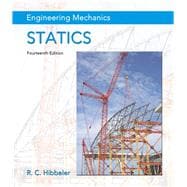The Fourteenth Edition includes new Preliminary Problems, which are intended to help students develop conceptual understanding and build problem-solving skills. The text features a large variety of problems from a broad range of engineering disciplines, stressing practical, realistic situations encountered in professional practice, and having varying levels of difficulty.
Note: You are purchasing a standalone product; Mastering Engineering does not come packaged with this content. Students, if interested in purchasing this title with Mastering Engineering, ask your instructor to confirm the correct package ISBN and Course ID. Instructors, contact your Pearson representative for more information.
If you would like to purchase both the physical text and Mastering Engineering, search for:
Package consists of:
- 0133915425 / 9780133915426 Engineering Mechanics: Statics
- 0135681987 / 9780135681985 Mastering Engineering Revision with Pearson eText -- Standalone Access Card -- for Engineering Mechanics: Statics & Dynamics









